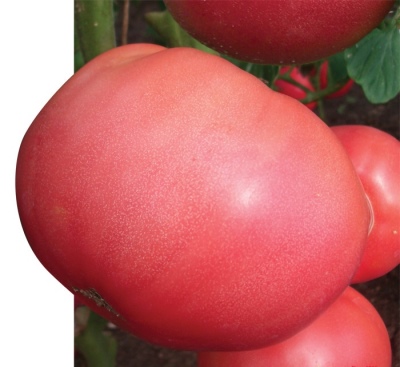
- Name synonyms: Pink King # VIII, Market King VIII
- Category: hybrid
- Growth type: indeterminate
- Appointment: fresh consumption
- Ripening period: mid-early
- Ripening time, days: 105-110
- Growing conditions: for open ground, for closed ground
- Transportability: high
- Bush size: tall
- Bush height, cm: 180
The pink king occupies a leading place in the mid-early group of large pink-fruited tomatoes. Has gained wide popularity among gardeners not only for large yields and tasty fruits, but also for excellent resistance to major diseases. First generation hybrid, created by domestic breeders. It was approved for use in 2007.
Description of the variety
Another name for this hybrid is Pink King # VIII or Market King VIII. This is a typical indeterminate variety. The bushes are tall, reaching a height of 180 cm, requiring multiple garters of the plant as it develops and the obligatory formation of 1-2 shoots, as well as pinching. Green foliage is small in volume.
The pluses include:
- good tolerance to temperature differences;
- resistance to lack of moisture;
- high productivity;
- excellent taste;
- tomatoes do not crack;
- good indicators of keeping quality and transportability;
- unpretentious care.
Among the minuses it is noted:
- great demands on lighting and irrigation at the growth stage;
- it is necessary to constantly make top dressing.
The main qualities of the fruit
The vegetables are characterized by a regular rounded shape and a beautiful pink color without a green spot at the base. Tomatoes are large, one weighs on average 250-350 grams. The skin is dense, smooth, with a glossy finish, does not allow the fruit to crack. The harvested crop can be stored for a long time and not lose its useful properties.
Taste characteristics
The pink king has excellent taste. The taste is sweet, with a pleasant sourness in the aftertaste. The pulp is quite dense and fleshy, with good juiciness. The fruits have a large amount of sugar content, dry matter in the range of 6%. The purpose in cooking is universal. Like all pink tomatoes, they are very good fresh. Due to the balanced taste, a very tasty juice is obtained.
Ripening and fruiting
Refers to medium early hybrids. Matures in 105-110 days. The crop is harvested for a long time, from July to September.
Yield
High-yielding variety. Up to 12 kg of tomatoes are harvested from 1 square meter.
The timing of planting seedlings and planting in the ground
Sowing of seeds is carried out at the end of March. First, they are disinfected in a solution of potassium permanganate and treated with a composition that increases germination. It is preferable to use ready-made soil for seedlings.
Growing healthy seedlings requires warmth and constant lighting. As soon as 2-3 healthy true leaves have appeared, it is necessary to pick the bushes. Before planting in the ground, hardening is carried out. For this, the seedlings can be taken out into the fresh air, leaving at first for 10-15 minutes, gradually increasing the time.
They begin to plant in open ground on the 50th day of growth. As a rule, in mid-May, when the threat of night frosts has passed. To speed up the adaptation period, a film shelter is recommended, and at the beginning of June, the seedlings are already comfortable in the open field without shelter.

Growing tomato seedlings is an extremely important process, because it largely depends on whether the gardener will be able to harvest at all. All aspects must be taken into account, from seedbed preparation to planting in the ground.
Landing scheme
When planting a culture, you should adhere to the scheme of 3-4 seedlings per 1 square meter. The manufacturer recommends planting plants at a distance of 40 x 70 cm.

Growing and care
Since the plant is powerful enough, it needs 1-2 stems formation and pinching, so that there is good aeration and there are no conditions for the appearance of diseases. In addition, due to the large weight of the fruit and rather large growth, a regular garter should be done.
The best predecessors for planting tomatoes are cabbage, field mustard, levkoy, garden radish, radish, turnip, rutabaga. But after pepper, eggplant and potatoes, the culture cannot be planted. Before planting, the land must be prepared, loosened and weeds are removed. Before planting, the landing pits are enriched with organic matter and supports are installed.
The variety is picky about lighting and watering regime. Lack of light pulls out the seedlings too much. If this happens, the tip can be cut off. Watered only with warm, settled water under the root. Top dressing is carried out 3-4 times per season. First, nitrogen-containing fertilizers are applied, then phosphorus-potassium nutrition is needed.




A plant needs different micronutrients at each stage of growth. All fertilizers can be divided into two groups: mineral and organic. Folk remedies are often used: iodine, yeast, bird droppings, eggshells.
It is important to observe the rate and period of feeding. This also applies to folk remedies and organic fertilizers.
Disease and pest resistance
Tomato Pink King has good resistance to many diseases. But if it is wrong to water it, then this can lead to the development of gray rot. This disease manifests itself gradually, on fruits, stems and foliage, round watery spots and gray mold are formed. After some time, the spots begin to grow, and a brown liquid appears from them.
If the area of infection is small, then it should be treated with copper sulfate at a concentration of 2%. If the area affected by the disease is extensive, it is recommended to remove such plants in order to prevent contamination of neighboring tomatoes.



























































































